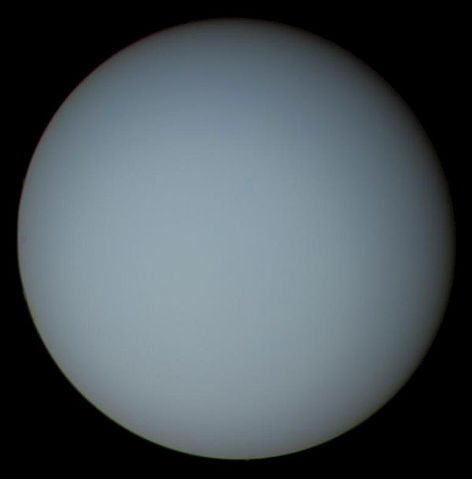 |
This is a file from the Wikimedia Commons. Information from its description page there is shown below.
Commons is a freely licensed media file repository. You can help.
|
| Description |
English: NASA photo of Uranus taken by Voyager 2. Caption: This pictures of Uranus was compiled from images recorded by Voyager 2 on January 10, 1986, when the NASA spacecraft was 18 million kilometers (11 million miles) from the planet. The images were obtained by Voyager's narrow-angle camera; the view is toward the planet's pole of rotation, which lies just left of center. The picture has been processed to show Uranus as human eyes would see it from the vantage point of the spacecraft. The dark shading of the upper right edge of the disk is the terminator, or day-night boundary. The blue-green appearance of Uranus results from methane in the atmosphere; this gas absorbs red wavelengths from the incoming sunlight, leaving the predominant bluish color seen here. Images shuttered through different colour filters were added and manipulated by computer, greatly enhancing the low-contrast details in the original images. The planet reveals a dark polar hood surrounded by a series of progressively lighter convective bands. The banded structure is real, though exaggerated here. The Voyager project is managed for NASA by the Jet Propulsion Laboratory.
Nederlands: Beeld van Uranus opgebouwd uit foto's welke zijn genomen door de Voyager 2 in januari 1986 toen het NASA ruimtevaartuig op een afstand van 18 miljoen km langs de planeet trok.
Česky: Fotografie Uranu od NASA získaná sondou Voyager 2.
Popis: Tento obrázek Uranu byl zkonstruován ze snímků Voyageru 2 10. ledna 1986, když byla sonda ještě 18 miliónů kilometrů od planety. Snímky pocházely z Voyagerovy úzkoúhlé kamery; pohled na výsledném obrázku směřuje proti planetárnímu pólu, který leží vlevo od středu. Obrázek byl upraven, aby ukazoval Uran, jak by ho viděly lidské oči z průhledu kosmické lodi. Zastíněný pravý horní okraj disku je terminátor — rozhraní dne a noci. Zelenomodrý nádech Uranu způsobuje methan v atmosféře; tento plyn absorbuje červenou složku slunečního světla, zbylé složky pak vytvářejí výslednou barvu. Temnější polární čepice je obklopena sérií postupně světlejších konvekčních proužků. Tato struktura je skutečná, i když na tomto obrázku naprosto nezřetelná. Projekt Voyager byl pro NASA řízen Jet Propulsion Laboratory.
|
| Date |
January 1986 |
| Source |
http://photojournal.jpl.nasa.gov/catalog/PIA01360 |
| Author |
NASA |
 |
This image or video was catalogued by Jet Propulsion Lab of the United States National Aeronautics and Space Administration (NASA) under Photo ID: PIA01360.
This tag does not indicate the copyright status of the attached work. A normal copyright tag is still required. See Commons:Licensing for more information.
|
Licensing
| Public domainPublic domainfalsefalse |
 |
This file is in the public domain because it was solely created by NASA. NASA copyright policy states that "NASA material is not protected by copyright unless noted". (See Template:PD-USGov, NASA copyright policy page or JPL Image Use Policy.) |
|
|
|
Warnings:
- Use of NASA logos, insignia and emblems are restricted per US law 14 CFR 1221.
- The NASA website hosts a large number of images from the Soviet/ Russian space agency, and other non-American space agencies. These are not necessarily in the public domain.
- Materials based on Hubble Space Telescope data may be copyrighted if they are not explicitly produced by the STScI. See also {{ PD-Hubble}} and {{ Cc-Hubble}}.
- The SOHO (ESA & NASA) joint project implies that all materials created by its probe are copyrighted and require permission for commercial non-educational use.
- Images featured on the Astronomy Picture of the Day (APOD) web site may be copyrighted.
|
File usage
The following pages on Schools Wikipedia link to this image (list may be incomplete):
All five editions of Schools Wikipedia were compiled by SOS Children. SOS Children believes education is an important part of a child's life. That's why we ensure they receive nursery care as well as high-quality primary and secondary education. When they leave school, we support the children in our care as they progress to vocational training or higher education. Have you heard about child sponsorship? Learn more...





